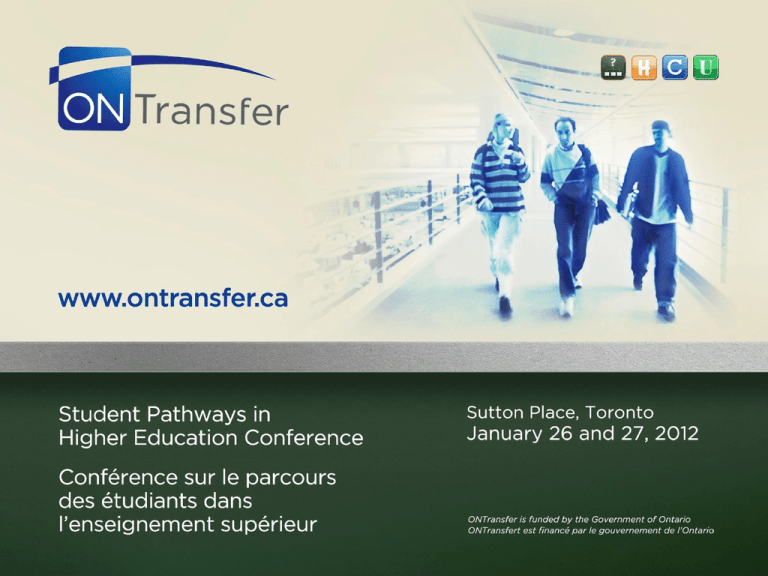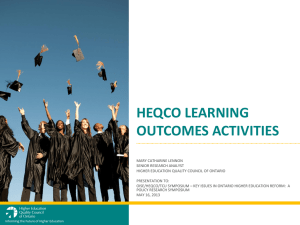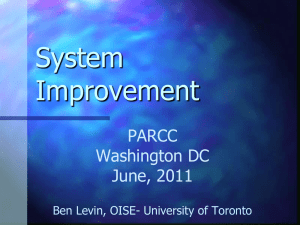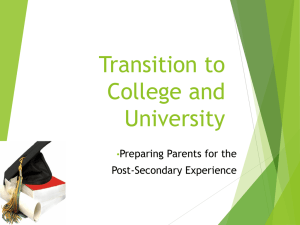Ursula McCloy`s Presentation
advertisement

MOBILITY IN ONTARIO’S PSE: CURRENT TRENDS URSULA MCCLOY, PHD STUDENT PATHWAYS IN HIGHER EDUCATION CONFERENCE JANUARY 26-27, 2012 Informing the Future of Higher Education HEQCO'S LEGISLATION: TRANSFER AND MOBILITY "Functions Section 6(c) to conduct research on all aspects of post-secondary education with a view to helping the Council achieve its object, including research, (i) on the development and design of various models of postsecondary education, (ii) on the means of encouraging collaboration between various post-secondary educational institutions in general and in particular in matters relating to the recognition of such institutions of courses and programs of study provided at other such institutions", PRESENTATION OUTLINE Focus on college to university pathway in Ontario: • Recent mobility trends in Ontario – How many? Share/number of students transferring – Who are they? Program areas, region, demographics • Student perceptions and experience of recent transfer students – – – – Reasons for transfer Timing of decision Information sources Satisfaction 4 Informing the Future of Higher Education CURRENT TRENDS IN TRANSFER PREVIOUS EDUCATION OF ONTARIO UNIVERSITY STUDENTS (NSSE) Informing the Future of Higher Education Source: Carleton NSSE Frequency tables 6 http://oirp.carleton.ca/surveys/html/surveys.htm COLLEGE GRADUATES ENROLLED IN DEGREE PROGRAMS: TRENDS Informing the Future of Higher Education Source: Ontario Graduate Satisfaction Survey 7 WHO TRANSFERS AND WHERE? CHARACTERISTICS Informing the Future of Higher Education Source: Ontario Graduate Satisfaction Survey 9 HOW DOES TRANSFER RELATE TO ACCESS? • Higher proportion of Aboriginal students, students with disabilities, low income, first generation students, students from smaller communities in Ontario colleges. • These groups are not actually “underrepresented” in colleges relative to the Ontario population; but are in university. • Would enhancing transfer increase access to university for these groups? – BC and American data indicate that these groups are in a higher proportion among transfer students. – Additionally, in Ontario’s destination based curriculum, course decisions as early as grade 9 can determine university access (need alternate pathway). TRANSFER STUDENTS MORE LIKELY TO BE FROM UNDERREPRESENTED GROUPS MAP OF ONTARIO COLLEGES BY REGION 12 Informing the Future of Higher Education % OF GRADUATES WHO GO ON TO UNIVERSITY DEGREES: BY COLLEGE REGION Informing the Future of Higher Education Source: Ontario Graduate Satisfaction Survey 13 GEOGRAPHIC MOBILITY: COLLEGE GRADUATES WHO TRANSFER REMAIN CLOSE TO HOME Informing the Future of Higher Education Source: Ontario Graduate Satisfaction Survey 14 DISTRIBUTION OF TRANSFERS RELATIVE TO UNIVERSITY ENROLMENT 15 Informing the Future of Higher Education % OF GRADUATES WHO TRANSFER TO UNIVERSITY DEGREES: BY COLLEGE PROGRAM TYPE Informing the Future of Higher Education Source: Ontario Graduate Satisfaction Survey 16 COLLEGE TRANSFERS MORE LIKELY TO ENTER SOCIAL SCIENCES AND BUSINESS Informing the Future of Higher Education Source: Ontario Graduate Satisfaction Survey; MTCU USER enrolment data 17 STUDENT PERCEPTIONS AND EXPERIENCE 18 Informing the Future of Higher Education REASONS FOR CONTINUING: % MAJOR REASON Informing the Future of Higher Education Source: Ontario Graduate Satisfaction Survey 19 DECISION TO TRANSFER OFTEN OCCURS AFTER ENTERING PROGRAM 100 90 17 80 32 70 60 50 46 53 54 46 43 49 After the program 40 72 30 55 20 10 26 26 32 33 35 During the program 40 At the start of the program Before the College program 0 Informing the Future of Higher Education Source: Ontario Graduate Satisfaction Survey 20 WOULD HAVE BEEN ACCEPTED WITHOUT ATTENDING COLLEGE FIRST: SAMPLE PROGRAMS Informing the Future of Higher Education Source: Ontario Graduate Satisfaction Survey 21 INFORMATION SOURCES FOR GRADUATES WHO TRANSFER (2009-10) Informing the Future of Higher Education Source: Ontario Graduate Satisfaction Survey 22 SATISFACTION OF GRADUATES WHO TRANSFER Informing the Future of Higher Education Source: Ontario Graduate Satisfaction Survey 23 SATISFACTION WITH ACADEMIC PREPARATION DIFFERS BY PROGRAM Informing the Future of Higher Education Source: Ontario Graduate Satisfaction Survey 24 WHAT DON’T WE KNOW? • Unsuccessful transfers (those who attempted • Students who transfer before completing college, and graduates who transfer after 6 months • # Credits transferred related to program affinity • Performance of students after transfer-need appropriate control group to evaluate • Is transfer an effective way to increase degree attainment for underrepresented groups? 25 Informing the Future of Higher Education NEXT STEPS • Continue to track transfer trends using available datasets • Incorporate OEN for tracking between institutions • Potential to mine NSSE data to measure engagement for transfer students (can also look at immigrant, Aboriginal status, first generation) • Track student performance through both sending and receiving institutions in articulated and non-articulated programs; controlling for previous academic (HS, previous PSE) socioeconomic, and demographic characteristics • Work with other provinces for data on Ontario transfer students • Look at transfer through learning outcomes perspective Thank you! Ursula McCloy, PhD umccloy@heqco.ca www.heqco.ca 27 Informing the Future of Higher Education





